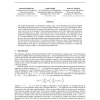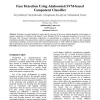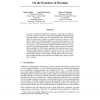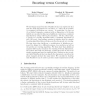114
Voted
CORR
2011
Springer
14 years 4 months ago
2011
Springer
The AdaBoost algorithm was designed to combine many “weak” hypotheses that perform slightly better than random guessing into a “strong” hypothesis that has very low error....
104
click to vote
COLT
2010
Springer
14 years 11 months ago
2010
Springer
Abstract. We pose the problem of determining the rate of convergence at which AdaBoost minimizes exponential loss. Boosting is the problem of combining many "weak," high-...
112
Voted
JMLR
2002
15 years 19 days ago
2002
We construct a framework which allows an algorithm to turn the distributions produced by some boosting algorithms into polynomially smooth distributions (w.r.t. the PAC oracle...
120
click to vote
ML
2000
ACM
15 years 23 days ago
2000
ACM
MultiBoosting is an extension to the highly successful AdaBoost technique for forming decision committees. MultiBoosting can be viewed as combining AdaBoost with wagging. It is abl...
140
Voted
SIGKDD
2008
15 years 27 days ago
2008
This paper presents our solution for KDD Cup 2008 competition that aims at optimizing the area under ROC for breast cancer detection. We exploited weighted-based classification me...
88
Voted
IJCV
2007
15 years 27 days ago
2007
This paper presents a method based on AdaBoost to identify the sex of a person from a low resolution grayscale picture of their face. The method described here is implemented in a...
105
click to vote
CORR
2008
Springer
15 years 1 months ago
2008
Springer
: Boosting is a general method for improving the accuracy of any given learning algorithm. In this paper we employ combination of Adaboost with Support Vector Machine (SVM) as comp...
109
Voted
APIN
2010
15 years 1 months ago
2010
Abstract. This paper introduces a robust variant of AdaBoost, cwAdaBoost, that uses weight perturbation to reduce variance error, and is particularly effective when dealing with da...
117
click to vote
NIPS
2003
15 years 2 months ago
2003
In order to understand AdaBoost’s dynamics, especially its ability to maximize margins, we derive an associated simplified nonlinear iterated map and analyze its behavior in lo...
99
Voted
NIPS
2003
15 years 2 months ago
2003
We investigate improvements of AdaBoost that can exploit the fact that the weak hypotheses are one-sided, i.e. either all its positive (or negative) predictions are correct. In pa...




